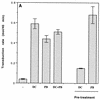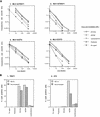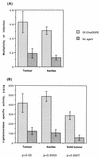Cationic liposomes enhance the rate of transduction by a recombinant retroviral vector in vitro and in vivo
- PMID: 9573249
- PMCID: PMC110029
- DOI: 10.1128/JVI.72.6.4832-4840.1998
Cationic liposomes enhance the rate of transduction by a recombinant retroviral vector in vitro and in vivo
Abstract
Cationic liposomes enhanced the rate of transduction of target cells with retroviral vectors. The greatest effect was seen with the formulation DC-Chol/DOPE, which gave a 20-fold increase in initial transduction rate. This allowed an efficiency of transduction after brief exposure of target cells to virus plus liposome that could be achieved only after extensive exposure to virus alone. Enhancement with DC-Chol/DOPE was optimal when stable virion-liposome complexes were preformed. The transduction rate for complexed virus, as for virus used alone or with the polycation Polybrene, showed first-order dependence on virus concentration. Cationic liposomes, but not Polybrene, were able to mediate envelope-independent transduction, but optimal efficiency required envelope-receptor interaction. When virus complexed with DC-Chol/DOPE was used to transduce human mesothelioma xenografts, transduction was enhanced four- to fivefold compared to that for virus alone. Since the efficacy of gene therapy is dependent on the number of cells modified, which is in turn dependent upon the balance between transduction and biological clearance of the vector, the ability of cationic liposomes to form stable complexes with retroviral vectors and enhance their rate of infection is likely to be important for in vivo application.
Figures







Similar articles
-
Virosomes: cationic liposomes enhance retroviral transduction.Nat Biotechnol. 1996 Mar;14(3):339-42. doi: 10.1038/nbt0396-339. Nat Biotechnol. 1996. PMID: 9630897
-
Rescue of retroviral envelope fusion deficiencies by cationic liposomes.J Gene Med. 2002 Nov-Dec;4(6):622-33. doi: 10.1002/jgm.310. J Gene Med. 2002. PMID: 12439854
-
Targeting viral-mediated transduction to the lung airway epithelium with the anti-inflammatory cationic lipid dexamethasone-spermine.Mol Ther. 2005 Sep;12(3):502-9. doi: 10.1016/j.ymthe.2005.03.033. Mol Ther. 2005. PMID: 16099413
-
Lipidic vector systems for gene transfer.Crit Rev Ther Drug Carrier Syst. 1997;14(2):173-206. Crit Rev Ther Drug Carrier Syst. 1997. PMID: 9107521 Review.
-
Long-term expression of the human alpha1-antitrypsin gene in mice employing anionic and cationic liposome vector.Biochem Pharmacol. 1997 Jul 1;54(1):9-13. doi: 10.1016/s0006-2952(97)00872-1. Biochem Pharmacol. 1997. PMID: 9296345 Review.
Cited by
-
The mannose-dependent epitope for neutralizing antibody 2G12 on human immunodeficiency virus type 1 glycoprotein gp120.J Virol. 2002 Jul;76(14):7293-305. doi: 10.1128/jvi.76.14.7293-7305.2002. J Virol. 2002. PMID: 12072528 Free PMC article.
-
Biopolymers augment viral vectors based gene delivery.J Biosci. 2019 Sep;44(4):84. J Biosci. 2019. PMID: 31502562 Review.
-
Retrovirus targeting by tropism restriction to melanoma cells.J Virol. 1999 Aug;73(8):6923-9. doi: 10.1128/JVI.73.8.6923-6929.1999. J Virol. 1999. PMID: 10400790 Free PMC article.
-
A cell line-based neutralization assay for primary human immunodeficiency virus type 1 isolates that use either the CCR5 or the CXCR4 coreceptor.J Virol. 1999 Nov;73(11):8966-74. doi: 10.1128/JVI.73.11.8966-8974.1999. J Virol. 1999. PMID: 10516002 Free PMC article.
-
3Beta [N-(N',N'-dimethylaminoethane)-carbamoyl] cholesterol (DC-Chol)-mediated gene delivery to primary rat neurons: characterization and mechanism.Neurochem Res. 1999 May;24(5):699-703. doi: 10.1023/a:1021012727796. Neurochem Res. 1999. PMID: 10344600
References
-
- Andersen K B. The fate of the surface protein gp70 during entry of retrovirus into mouse fibroblasts. Virology. 1985;142:112–120. - PubMed
-
- Andersen K B, Nexo B A. Entry of murine retrovirus into mouse fibroblasts. Virology. 1983;125:85–98. - PubMed
-
- Aubin R A, Weinfeld M, Mirzayans R, Paterson M C. Polybrene/DMSO-assisted gene transfer. Mol Biotechnol. 1994;1:29–48. - PubMed
Publication types
MeSH terms
Substances
LinkOut - more resources
Full Text Sources
Other Literature Sources

